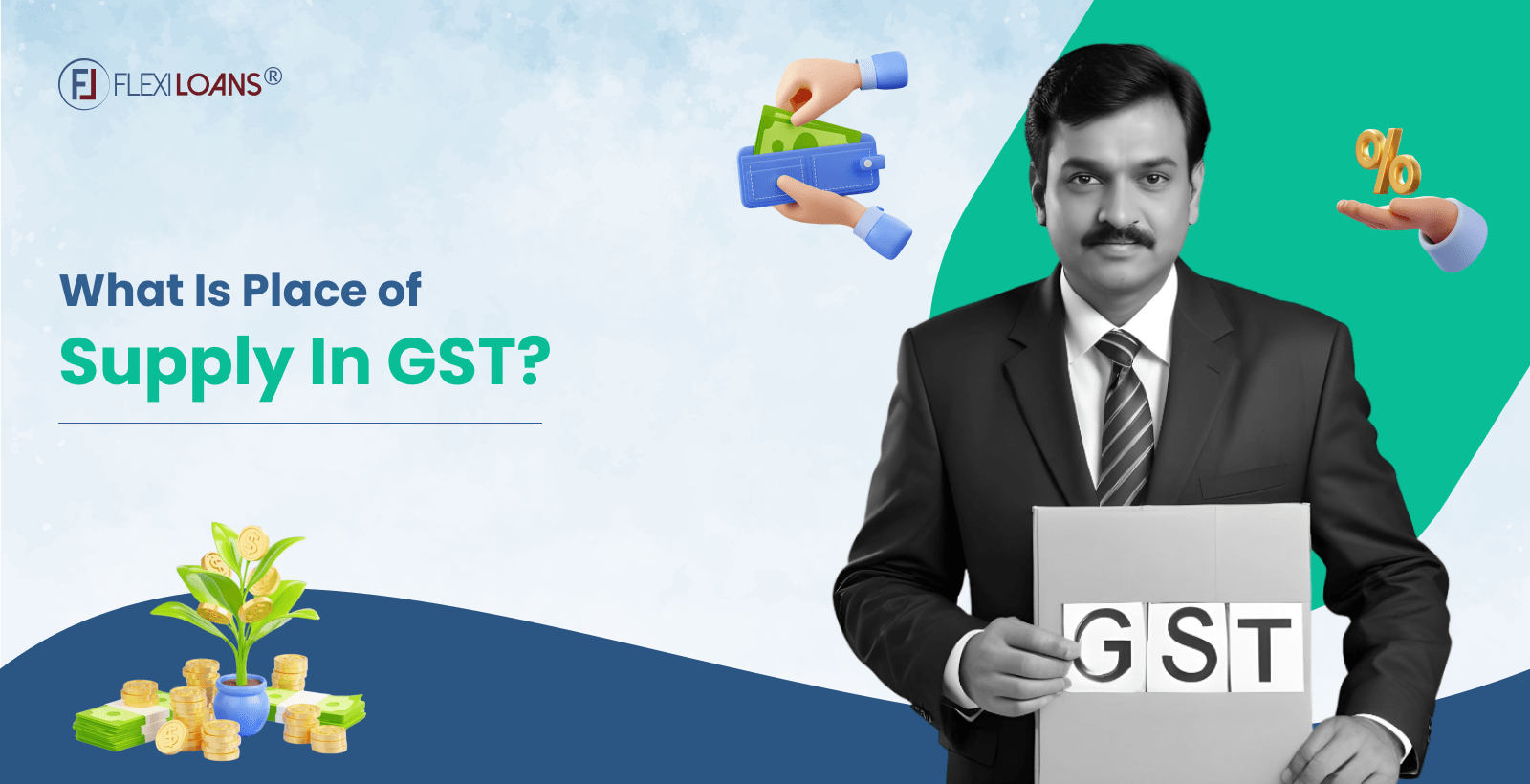Aug 29, 2024
Nov 27, 2025

The place of supply in GST, implemented in 2017, forms a vital part of the Indian tax system. GST is a destination-based tax, meaning it is levied where the products or services are consumed. To ensure appropriate application of GST, it is critical to identify the point of supply(POS) correctly. Let us explore the significance of ascertaining the place of supply under GST of services, why it’s important, the legal framework governing it, integrated GST meaning, and the specific rules for determining the place of supply of goods and services.
The Place of Supply Meaning Under GST?
Under GST law, the place of supply is the location of the recipient of goods or services, usually the recipient’s registered address. However, different types of transactions might have specific rules for determining the place of supply GST, which can influence the applicable tax rate.
For instance, a manufacturing company in Pune supplies goods to Gujarat. The place of supply of services in GST is Gujarat transaction and the transaction is classified as an inter-state supply, attracting IGST. Whereas, a telecommunication organisation in Pune supplies services within the state, then the place of supply of telecommunication services shall be same state, the transaction would be considered intra-state, and both CGST and SGST would be levied.
Necessity of Determining the Place of Supply
Determining the place of supply of services is essential factor as it influences the kind of GST levied that includes, Integrated GST (IGST), Central GST (CGST), State GST (SGST), or Union Territory GST (UTGST). The kind of supply (interstate or intrastate) and the locations of the provider and recipient decide which of these taxes will be applicable. Correctly identifying the POS assures GST compliance and prevents legal and financial issues.
Key Provisions of Chapter V of the IGST Act for Place of Supply
Chapter V of the Integrated Goods and Services Tax (IGST) Act provides a legislative framework for establishing the place of supply in GST. This chapter, encompassing Sections 10 to 14, provides the detailed provisions that must be followed to identify the place of supply in various scenarios:
- Section 10: Governs the place of supply of goods in India, except imports and exports.
- Section 11: Addresses the place of supply for imported and exported commodities.
- Section 12: Determines the place of supply of services when both the supplier and the recipient are in India.
- Section 13: Applies to services where either the provider or the recipient is situated outside India.
- Section 14: Provides special rules for online information and database access or retrieval services (OIDAR).
Also know about Business Loan on GST
Understanding the Rules of Place of Supply GST
The POS regulations under GST defines the type of tax that applies based on the location of the supplier and receiver. IGST is charged on interstate supplies, whereas CGST and SGST (or UTGST) are imposed on intrastate supplies. The proper classification of the supply type (interstate or intrastate) is crucial for compliance. Let us understand the difference between inter-state supply and intra-state supply:
For instance, supply of tea leaves from Assam to Mumbai is a type of interstate transaction of services where IGST will be levied. Whereas, delivering tea leaves from one place to another place within the state of Assam is a type of intra-state transaction, this will undergo CGST + SGST taxation.
Classifying the Place of Supply for Goods Under GST
When identifying the place of supply of goods, numerous circumstances must be considered:
1. Movement of Commodity
- With Movement: If the items are transported from one place to another, the POS is where the goods are delivered.
- No Movement of Commodities: When there is no movement involved, the POS is where the commodities are situated at the time of delivery. Consider the following scenarios:
- The place of supply for items getting assembled or installed, is where the assembly or installation occurs.
- If goods are provided on board a conveyance, the place of supply is where they are taken on board.
2. Bill-to-Ship-to Transactions
Under the Section 10(1)b of IGST Act, when items are delivered to a receiver at the request of a third party, the POS is assumed to be the third party’s primary place of business. For instance, Company X of Mumbai orders goods from Supplier Y of Kolkata to deliver the goods to a location in Z in Uttarakhand. The place of supply of goods is automatically assumed to Mumbai who ordered the goods and IGST will be applicable.
Specifying the Place of Supply of Services Under GST
Unlike goods, services are intangible, making the determination of the place of supply more complex. The rules vary depending on whether the recipient is registered or unregistered and the nature of the service:
- Services to Registered Person: For services provided to a registered person, the place of supply of services is the recipient’s registered business location. Intra-state transactions are subject to CGST and SGST and IGST levied for the inter-state exchange of services.
- Services Unregistered Person: In case transaction of services is provided to an unregistered person, given the the provider has the recipient’s address, the POS is their available address. In case the recipient’s address is not found, the supplier’s location is used instead.
- Immovable Property Services: The location of the immovable property is the place of supply of services under GST. This rule applies to the services offered by architects, interior decorators, surveyors, and engineers.
Special Rules for the POS for Specific Services
Different services have distinct standards for defining the place of supply. Here’s how place of supply of services in GST is imposed depending on the type of the service:
1. Specific Services
- Restaurant and Catering Services: The establishment where the services are rendered.
- Personal Grooming and Health Services: The location where the service is provided, reflecting the physical nature of these services.
- Training and Performance Appraisal: For registered recipients, it is the recipient’s address. For unregistered recipients, it the place where the exchange of services take place.
2. Telecommunication Services
The place of supply of telecommunication services shall be determined by the recipient’s address.
- Fixed services, such as leased circuits and internet, the POS is where the connection is installed.
- Mobile Services:
- For post-paid services, it is the recipient’s billing address.
- For the prepaid services, it is the location at which they are sold.
- Electronic recharges are depending on the recipient’s location.
3. Financial Services – Place of Supply and Business Loan
When it comes to financial services like business loans, the place of supply regulations under GST become essential. They dictate how and where the appropriate tax is levied. Unlike products or other tangible services, loan for business are financial services, hence the place of delivery is mostly dependent on the recipient’s location.
FlexiLoans is a fintech organisation offers multiple types of online business loan, useful for business with limited credit history and no mortgage. Additionally, it provides these collateral free business loans with flexible repayment options that allows businesses to borrow funds as needed and repay at their convenience.
Determining the Place of Supply for Business Loan
For line of credit loans, the place of supply is often based on the following criteria:
- Recipient’s Location: If the business loan receiver is a GST-registered person, the place of supply is their registered business address. This ensures that the appropriate GST (if any) is paid based on the borrower’s location, rather than the lender’s. For instance, a manufacturer applies for machinery loan and MSME loan for their business operations. They are situated in Guwahati. The POS for these required term loans is their business address in Guwahati.
- Unregistered Recipients: For unregistered individuals or entities (such as small enterprises that may not be GST registered), the place of supply of services in GST is their location as recorded by the provider (the bank or financial institution). For instance, a weaver in the state of Chhattisgarh is looking out for small business loan to fund her ongoing business operations but she is not registered under GST. This means that the creditor can consider any location under her name for the required business loans for women, her home address or address of her immediate family.
- Cross-Border Loans: If a loan is issued to a borrower located outside of India, the service is considered an export. Exports of services are often zero-rated under GST, which means no GST is levied and the lender can receive a refund of input tax credits.
GST for Business Loans
Mostly, the interest rates for business loans is excluded from GST, meaning the loans themselves are not subject to GST. Other services, such as the business loan processing costs, may be liable to GST.
Impact on Businesses
Understanding the place of supply regulations governing loans for business is crucial for proper financial planning and compliance that further enhances your future eligibility for business loans. Knowing where GST is applicable might influence loan structure, cost estimates, and overall cash flow management.
4. Transportation Services
- Goods Transport:
- For registered receivers, it is the delivery location of goods.
- For unregistered receivers, it is where products are transported.
- Passenger Transport:
- For registered recipients, it is the recipient’s location.
- For unregistered recipients, it is where the passenger boards the conveyance.
- Onboard Conveyances: GST levied according to the location of the first scheduled departure point.
5. Place of Supply in Exports and Imports
- Imports: IGST is levied on imported products at the importer’s location of delivery.
- Exports: The destination for exported products is outside India. Such transactions are usually zero-rated, which means no GST is imposed, and exporters can claim refunds for GST paid during manufacture.
Conclusion
The place of supply in GST is a cornerstone of tax compliance, influencing the type of tax levied and ensuring the proper distribution of tax revenue between states. Whether dealing with domestic or international transactions, understanding the place of supply rules is essential for minimizing risks and ensuring smooth tax management. By adhering to these rules, businesses can ensure that they are correctly applying GST, taking advantage of available tax credits and exemptions, and maintaining compliance with the law.
FAQs
Place of supply means the location where the goods are delivered or where their movement ends.
Integrated GST (IGST) is a type of Goods and Services Tax (GST) that is levied on inter-state transactions of goods and services in India.
While the loan principal and interest are generally exempt from GST, any additional services related to the loan are governed by the POS rules. This ensures that any GST applicable is correctly attributed to the appropriate state or jurisdiction, maintaining compliance and optimizing tax liability for businesses.
“स्थान की आपूर्ति” का अर्थ है वह स्थान जहां माल या सेवाएं प्रदान की जाती हैं। यह आमतौर पर प्राप्तकर्ता के पंजीकृत पते का संदर्भ होता है।
Incorrect determination can lead to incorrect tax payments, potential penalties, and legal complications.







